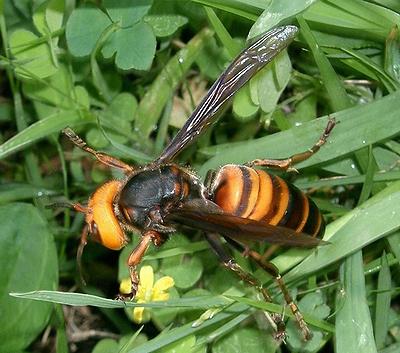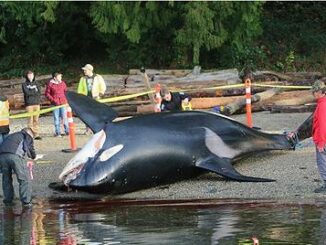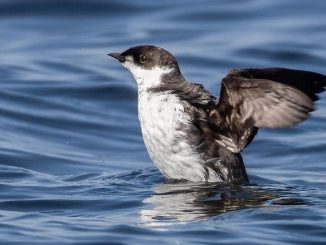
OLYMPIA, Washington, May 4, 2020 (ENS) – “Murder hornets,” known officially as Asian giant hornets, Vespa mandarinia, have made their first appearance in the United States. These giant stinging insects, the world’s largest species of hornet, are an invasive species and a known predator of honeybees.
They were found for the first time in the United States late last year in northwest Washington, according to the state’s Department of Agriculture. The agency warns that the Asian giant hornet poses a serious threat to Washington honeybees and the honeybee industry, already under pressure from pesticides, varroa mites and colony collapse disorder.

Measuring up to two inches long with distinctively large orange heads and black eyes, Asian giant hornets were verified in the northwest Washington cities Blaine and Bellingham as of February 2020, according to the Washington Invasive Species Council.
Though not typically aggressive toward humans, they will attack anything that threatens their colonies, which usually nest in the ground. They can sting multiple times and have powerful venom that can inflict serious injury, or in some cases, death.
Doctors advise that stings from these hornets should be treated with an ice pack or cold compress to reduce inflammation and the spread of venom. Anyone stung multiple times or showing serious symptoms should seek medical attention immediately.
The insects are called murder hornets because in late summer through fall, they can attack honeybee colonies en masse, resulting in the complete destruction of a healthy colony in a matter of hours. The attack leaves piles of decapitated victims in front of the hive, the Council says.
The Washington State Department of Agriculture, WSDA, says that while the extent of possible damage to Washington’s honeybee industry is not yet known, a similar hornet in Europe has reduced beehives by 30 percent and up to two-thirds of the honey yield.
“Asian giant hornet attacks and destroys honeybee hives. A few hornets can destroy a hive in a matter of hours. The hornets enter a “slaughter phase” where they kill bees by decapitating them,” the WSDA said.
“They then defend the hive as their own, taking the brood to feed their own young. They also attack other insects but are not known to destroy entire populations of those insects,” the agency said.
Now, Washington State University Extension scientists are partnering with state agencies, beekeepers, and citizens to identify and report the invasive insects.
Susan Cobey, a bee breeder with Washington State University’s Department of Entomology, said, “They’re like something out of a monster cartoon, with this huge yellow-orange face.”

Scientists with the WSDA Pest Program are taking the lead on finding, trapping, and eradicating the pest. WSDA will begin trapping for queens this spring, with a focus on Whatcom, Skagit, San Juan, and Island counties.
“Our focus is on detection and eradication,” said WSDA entomologist Chris Looney. The agency plans to collaborate with local beekeepers and WSU Extension scientists and entomologists, with Washington State University focusing its efforts on management advice for beekeepers.
Regular beekeeping suits are poor protection against this hornet’s sting, said Looney, as the hornets’ long stingers can penetrate ordinary suits. The WSDA has ordered special reinforced suits from China.
The agency will engage beekeepers and scientists in its effort to trap the giant hornets this spring and summer, but the WSDA warns that most people should be extremely cautious around the insects, saying, “The stinger of the Asian giant hornet is longer than that of a honeybee and the venom is more powerful than any local bee or wasp. If you find a colony do NOT attempt to remove or eradicate it.”
“Don’t try to take them out yourself if you see them,” says Looney. “If you get into them, run away, then call us! It is really important for us to know of every sighting if we’re going to have any hope of eradication.”
Report any Asian giant hornet sightings immediately to the WSDA Pest Program at 1-800-443-6684, pestprogram@agr.wa.gov or online at agr.wa.gov/hornets.
In their home forests and low-elevation mountains of eastern and southeast Asia, the hornet feeds on native wasps and bees. In Japan, it devastates the European honey bee, which has no effective defense. Japan reports around 50 people a year die from deadly hornet attacks.
They kill people in China too. Between July and October 2013, giant hornet attacks killed 42 people and injured 1,675 others in three cities in China’s Shaanxi province, according to the local government. Among those injured in those attacks, 206 were hospitalized for treatment.
It is not known how or where the Asian giant hornet first arrived in North America. Insects frequently stow away in international cargo, but the giant hornets likely entered the United States from British Columbia, Canada, Washington State’s neighbor to the north.
In August 2019, the British Columbia Ministry of Agriculture confirmed the presence of giant hornets on Vancouver Island, British Columbia, with a nest discovered and then destroyed in the city of Nanaimo.
A report published by BC’s Ministry of Agriculture says, “Three large insects found in the Nanaimo area were confirmed by Canadian and international experts as Asian giant hornets,” the report explains, marking the first time they have been discovered on Vancouver Island and in British Columbia.
In British Columbia, anyone who believes they have seen an Asian giant hornet is asked to call the Invasive Species Council of BC at 1-888-933-3722 or report online.
Copyright Environment News Service (ENS) 2020. All rights reserved.
© 2020, Environment News Service. All rights reserved. Content may be quoted only with proper attribution and a direct link to the original article. Full reproduction is prohibited.



